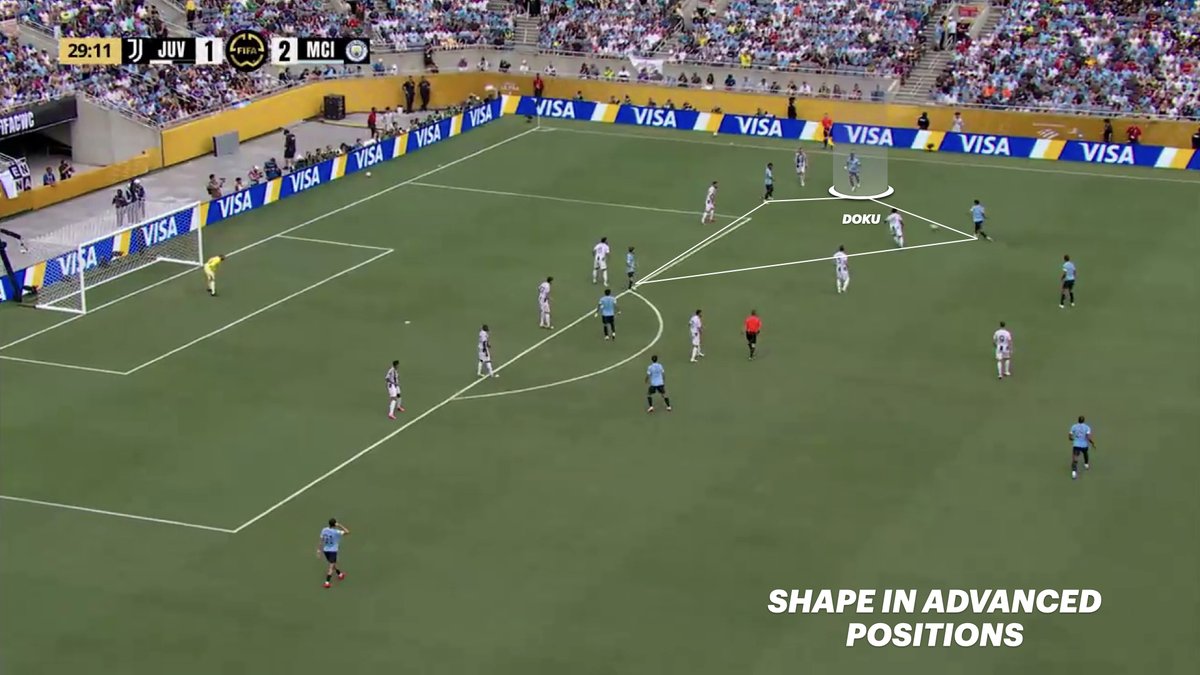Observations From Man City v Juventus
Some recycled shapes and patterns, and some new. I'll add to this as the day goes on.
Let's start with lower build-up play. The full-backs hold the width with Doku and Savinho playing inside. Silva and Reijnders drop in line with Rodri.
Some recycled shapes and patterns, and some new. I'll add to this as the day goes on.
Let's start with lower build-up play. The full-backs hold the width with Doku and Savinho playing inside. Silva and Reijnders drop in line with Rodri.

With Juventus marking man-to man, Silva and Reijnders were happy to take their markers into deeper positions. 

This was the trigger for Doku and Savinho to narrow their markers, forcing Juventus to have little horizontal coverage on the last line of their defence. 

Which Ederson can pick out all day.
Nothing new here, but a warning to any teams going man-to-man against City.
Pep “Ederson was an incredible quarterback today, making incredible long balls for Omar and Erling"
Nothing new here, but a warning to any teams going man-to-man against City.
Pep “Ederson was an incredible quarterback today, making incredible long balls for Omar and Erling"

The 4th goal, same routine.
If Juventus kept horizontal coverage on the defensive line, then Ederson would find Savinho or Doku in their inside positions.
The role of Ederson can't be understated. Juventus' only solution would be to apply pressure, opening up the link passes to find the spare man.
The role of Ederson can't be understated. Juventus' only solution would be to apply pressure, opening up the link passes to find the spare man.

Higher up the pitch, City moved to their more recognisable shape with the wingers holding the width.
We will come to the slight tweak on this, but this shape is nothing we haven't seen before.
We will come to the slight tweak on this, but this shape is nothing we haven't seen before.

The wide connections offering constant width, depth and support options with enough rotations and movement to keep the opponent guessing to which player will offer each option.
Reijnders offers the depth in this instance with a run in behind.
Reijnders offers the depth in this instance with a run in behind.

The beauty of Nunes at right back is his ability to identify the runs beyond. He changes his support position to offer depth and create the second goal. 

Rodri can offer the support position in this instance, and this allows an extra player (Silva) in the box.
The biggest tactical difference in last night's game. The role of Doku.
Part of the usual attacking shape for 70% of the game but adding an unpredicatblility for the other 30%
Here, Doku is on the right next to Savinho. The 3 man side connection becomes 4.
Part of the usual attacking shape for 70% of the game but adding an unpredicatblility for the other 30%
Here, Doku is on the right next to Savinho. The 3 man side connection becomes 4.

This forces Ait-Nouri to hold the width and in turn City can't cover their counter-pressing positions on the edge of the box.
It will be interesting to see how this develops. The freedom Doku is allowed does impact the rest defence structure to counter-press.
It will be interesting to see how this develops. The freedom Doku is allowed does impact the rest defence structure to counter-press.

When Doku holds the width, City have their rest defence structure with Rodri +2 more preventing any easy escape on the second line of defence.
Will the unpredictability of a roaming player compromise this? Is the risk worth the reward? One to watch.
Will the unpredictability of a roaming player compromise this? Is the risk worth the reward? One to watch.

• • •
Missing some Tweet in this thread? You can try to
force a refresh















